Scientific name
Campoletis chlorideae Uchida
Taxonomic position
Hymenoptera: Ichneumonidae
Diagnosis
Head, thorax and first abdominal segment black, abdominal segments II to VI orange-yellow with a median black area. Antenna dark pitchy brown to black. Maxillary and labial palpi white. First two
pairs of legs orange-yellow, except trochanter creamy yellow to white; hind coax dark brown to black, trochanter I light brown, trochanter II creamy white; hind tibial base and apex dark brown, median area yellow; hind tarsi dark brown. Apical margin of clypeus with an obtuse median tooth (Fig. 1). Eye margin weakly indented opposite antennal socket. Areolet in fore wing receiving second recurrent vein a little before middle (Fig. 2). First abdominal segment moderately decurved, with a moderately slender petiole and moderately stout post-petiole.
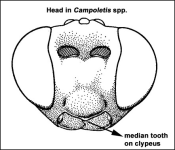 Fig. 1. Head Fig. 1. Head
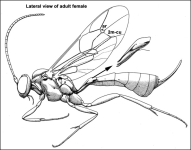 Fig. 2. Adult female, lateral view Fig. 2. Adult female, lateral viewImages

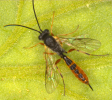

 Adult female, dorsal view Adult female, dorsal view
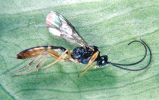 Adult in profile Adult in profile
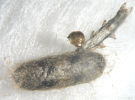
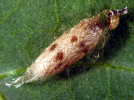 Cocoon of C. chlorideae Cocoon of C. chlorideae
Distribution
India: Widely distributed. China. Japan.
Hosts
Larval parasitoid of Noctuidae, particularly Helicoverpa armigera (Huebner) and Spodoptera litura (F.). It is a key parasitoid of the early-instar larvae of H. armigera throughout India. Its numbers in nature appear to have come down drastically in recent years, possibly due to indiscriminate use of insecticides and other factors.
Field application
The recommended dosage is 15000 adults / hectare. One to three releases are necessary depending on the population density of young larvae in the field. Field utilization of this parasitoid is severely limited due to the lack of effective mass production techniques and the highly male-biased sex
ratio.
|